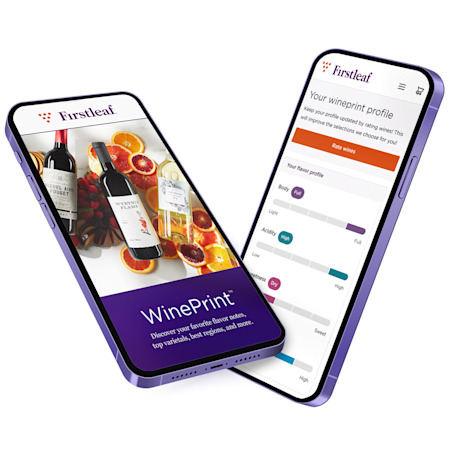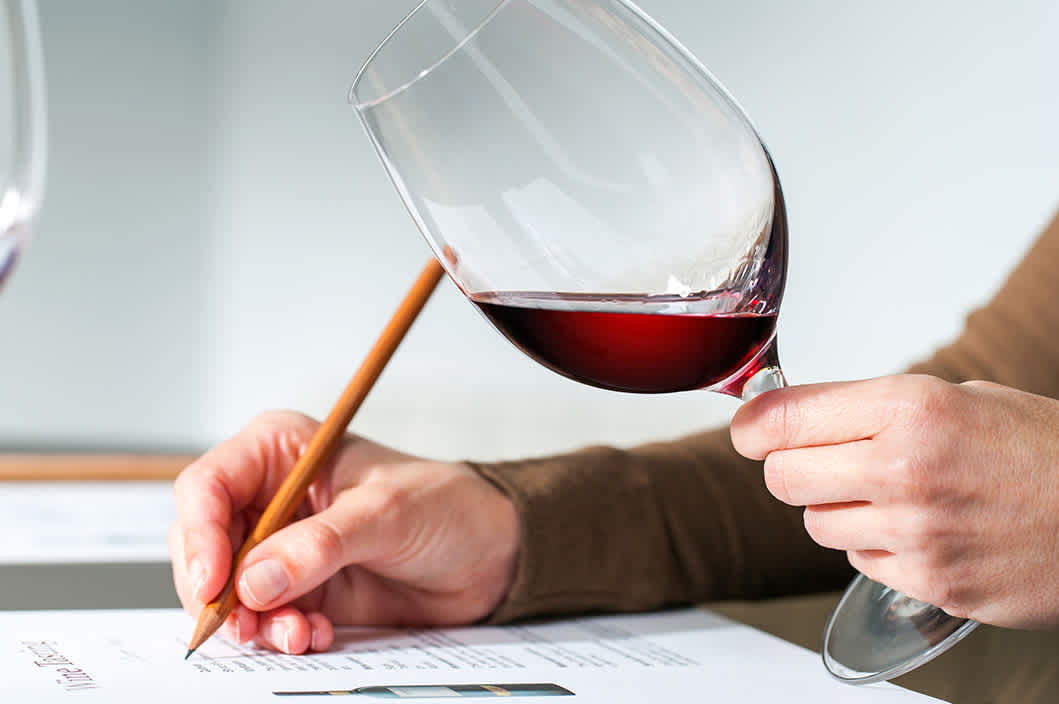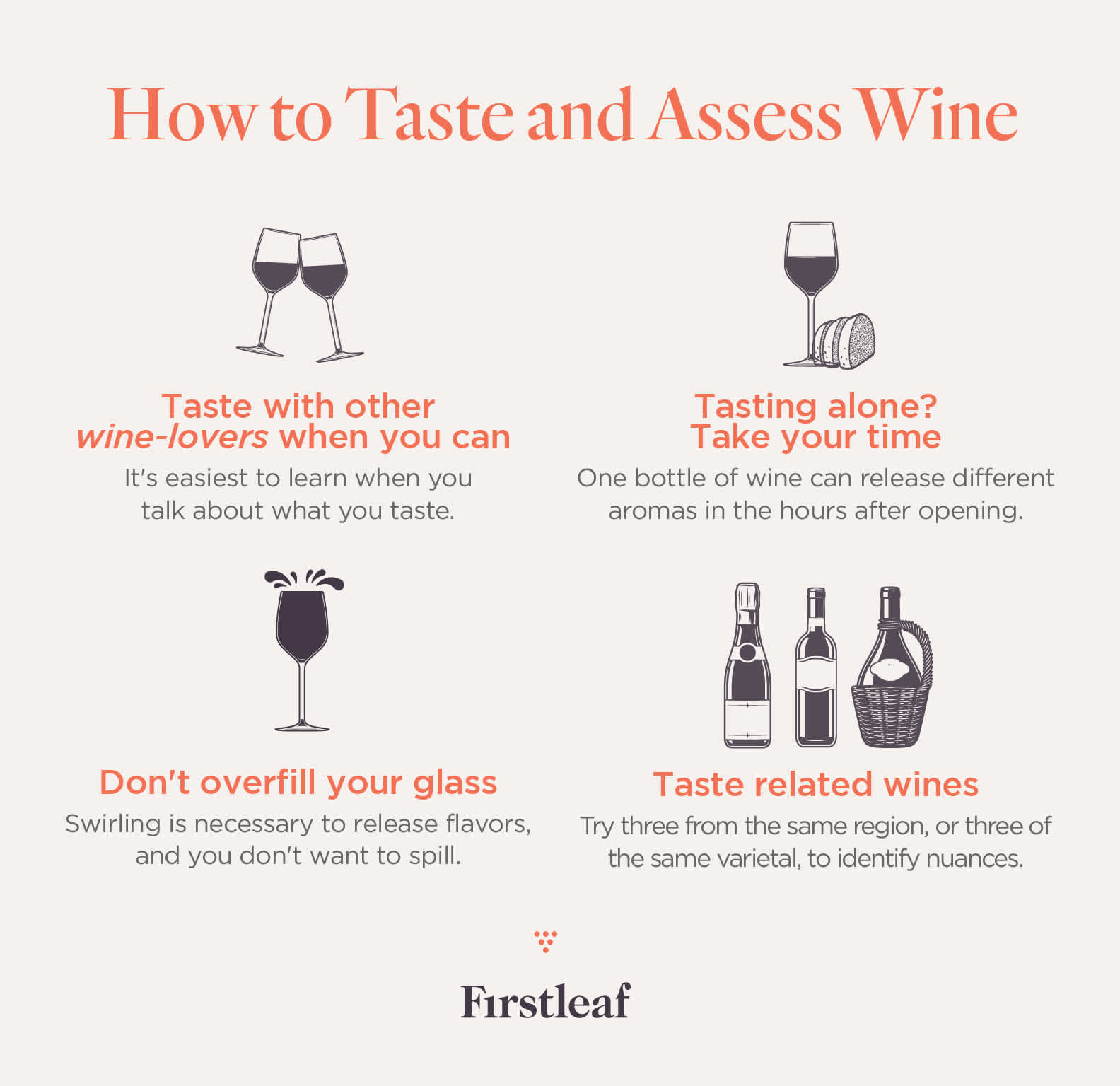How to Taste Wine and Assess Wine
Learn all about how to smell, taste, and evaluate a wine.
Refining your tasting skills is a fun way to increase your enjoyment of wine and appreciation for its many styles. You may even discover new favorites along the way. Our Wine Tasting, Made Simple exercise will teach you how to taste wine step-by-step while building your confidence with every swirl. Fill a glass with something new from our wine store, or grab your go-to bottle. You can make it a social activity with friends and family or sharpen your senses solo.
IN THIS ARTICLE:
Quick tips to get the most out of your wine tasting
Wine is meant to be enjoyed your way. You don't have to be a critical wine thinker to be an avid wine drinker. Tasting wine can be a fun and educational way to develop your palate and learn about your wine preferences. That said, you don't need to do a full-scale evaluation of every wine that enters your glass. Keep it lighthearted, have fun and be patient with yourself as you learn this new skill. Here are some tips to help along the way.
Taste with other people. It's easiest to learn if you can talk about what you taste. Everyone's palate is different. Hearing what others are tasting can help direct your perception as well. Wine is nuanced, and evaluating it is easiest with others. Find some like-minded wine lovers if you can, or make it a joyful bonding experience with a spouse or friend that is willing to try.
Take your time. Who wants to drink wine in a rush? As we said before, wine is meant to be enjoyed. Relax and give yourself time to get the most out of your tasting activity. Slowing the pace also allows your wine to open up in the glass, releasing even more aromas and flavors.
Save room to swirl. Swirling wine will release its aromas. Be careful not to overfill your glass. A standard serving of wine is five fluid ounces, which allows space for the glass to funnel aromas to your nose. Plus, a wine glass filled up to the top will likely spill, and there's nothing more heartbreaking than wine ending up on your clothes rather than your palate. Visit our wine school for tips on how and why we swirl wine.
Taste related wines. Tasting wines side by side will allow you to recognize the nuances between regions, winemaking styles and price points. For example, compare Cabernet Sauvignons from California and Washington. Or get specific and compare Sonoma County to Columbia Valley. You could get adventurous and compare Cabernets from the United States to ones from Argentina or Australia.
Wine tasting basics
With those tips in mind, it's time to fill a glass and follow along with our Wine Tasting, Made Simple exercise. Grab your favorite red, white or rosé and join us as we walk you through four simple steps.
Step one: Look
Step two: Sniff
Step three: Sip
Step four: Describe
At the end of this exercise, you will be able to craft your own DIY wine description like the one below.
I like the 2020 Wisdom Point Cabernet Sauvignon from Western Cape, South Africa. It has aromas of dried herbs and green bell pepper. It is dry with high acidity and tastes like redcurrant, black cherry, and licorice. It has medium tannins and a full body with a medium finish.
Step one: Look
How to assess the color of a wine
Look at the wine against a white background. What color can you see? Does your white wine have a greenish tint or look more gold? Does your red wine look closer to purple or garnet (brick red)?
Facts about wine color:
White wines get their color from phenolic compounds called flavonols. These yellow pigments make them appear more gold. Wines from sunny climates have more flavonols than wines from cooler climates, meaning they will be more golden in hue.
White wines can also gain color as they age. So older white wines may have more color than younger wines.
Red wines get their color from phenolic compounds called anthocyanins. These compounds, combined with the wine's acidity, age, winemaking techniques and grape variety, will determine its color.
Red wines lose color as they age.
Rosé wine's color largely depends on how long it spends in contact with its grape skins during production. In general, the longer, the deeper.
Rosé wines fade from purply pink to orange as they age.
Is the wine clear, or is it hazy? Most wines will appear clear. If it is hazy, check the label for the words "unfiltered" or "unfined." This is common with natural wine styles. Are you tasting sparkling wine? Take note of the bubbles. Are they small and graceful or large and lively? This can hint at how the sparkling wine was made, which we discuss in detail here.
What are wine "legs"?
Wine legs or tears refer to droplets of liquid that stick to the inside of your glass after swirling. This is due to the Marangoni Effect, an interaction between evaporating alcohol and the surface tension of the liquid stuck to the glass's sides. A common wine myth is that legs are associated with wine quality, but science has proven this wrong. In general, wines with higher alcohol content or sweet wines with high residual sugar will have heavier legs. The temperature and humidity of the room where you're tasting can also affect how the liquid sticks to the side of the wine glass. So can the temperature of the wine. So while "legs" can give you a general impression about the alcohol content of the wine, they don't tell you whether a particular wine is better than any other.
Step two: Sniff
How to smell wine
Sniff like a sommelier. Keep your mouth slightly open and take a combination of short whiffs and longer inhales. By taking lots of short whiffs, you can continuously reintroduce the wine's aromas to your senses, while larger inhales draw the scents further back. To assess the nose of a wine, you'll want to look at two things.
Intensity
light - medium - intense
How aromatic is this wine? Start with your glass 10 inches from your nose and swirl. Slowly move it closer until you can smell the wine. Could you smell it from 10 inches away? That is intense. Do you have to stick your whole nose into the glass? That is light.
Aromas
Write down 3 – 4 aromas
What can you smell? The list below includes common aromas and flavor descriptors found in wine. Start with a broad category (e.g., Red Fruits), then scan the section to narrow it down to a specific scent (e.g., Strawberry).
Did you know?
Our sense of smell is responsible for roughly 80% of what we taste.
The average person can remember a smell with 65% accuracy after one year, making it the longest-lasting of all the senses.
Our sense of smell renews on a 28-day cycle, meaning we essentially get a whole new nose every month.
Olfaction, our sense of smell, is directly linked to our memory and emotions, which explains why certain scents can mentally transport us to a specific moment in time. This can improve your ability to recognize aromas in wine. When you encounter a new scent, pause to observe your surroundings and emotional state. Taking note of these little moments will help build your personal catalog of scents. For example, the distinct aromas of freshly cut grass found in some Sauvignon Blancs can conjure memories of summer lawn games at your childhood home.
Step three: Sip
How to taste wine
Once a wine touches your palate, the whole picture starts to come together. The easiest way to assess the six wine components below is to take a new sip for each one, focusing solely on the category at hand.
Sweetness
dry - off-dry - sweet
Is the wine sweet or dry? Sweetness refers to the presence of remaining grape sugars in the wine. If the wine smells fruity, it may trick your brain into believing it tastes sweet, even if it has no sugar. Here is a fun trick to see if you're actually tasting sugar. Plug your nose and briefly dip your tongue in the wine. Keep your nose plugged and smack your lips. Do you still taste sweetness? If it's not sweet at all, that is a dry wine. If it tastes like you should drink it for dessert, that's sweet! Somewhere in-between? That is off-dry.
Acidity
low - medium - high
Is this wine crisp and refreshing or mild and mellow? Swish the wine around your mouth. Swallow and partially open your mouth. How much are you salivating? Only a little, or do you have a mouthful of saliva? The more mouthwatering the wine, the higher in acidity!
Flavors
Write down 3 - 4 flavors.
What flavors do you taste? Like the aromas, use the list above to reference common aroma and flavor descriptors found in wine. Keep in mind flavors will often mirror the aromas. Can you taste anything new? Has anything faded?
Tannin
low - medium - high
Tannins are most common in red wines. Skip this step when tasting a white or rosé. Tannins determine if a wine feels soft and gentle or structured and firm. Swish the wine around your mouth, then swallow. How dry does your mouth feel? Is it barely noticeable, or do your gums feel grippy and dry, similar to how they feel after sipping black tea?
Body
light - medium - full
How heavy does the wine feel? Move the wine around in your mouth. Does it feel light, like water? Or full, like whole milk? Generally, the higher the alcohol content of the wine, the heavier the body, but not always. Tannin and residual sugar can also add to the body of a wine.
Finish
short - medium - long
How long do the flavors stay with you? This is known as the “finish" of a wine. How long can you taste the wine after you've swallowed it? Is the flavor gone immediately, or does it linger? Less than 3 seconds is short, while around 30 seconds is long.
Step four: Describe
Final observations of a wine
The most important step when tasting wine is determining whether or not you like it. After all, it could be the world's most expensive, high-quality wine, but that means nothing if you can't stand the taste. Take a moment to reflect on the wine you tasted. Would you drink it again? Would you recommend it to a friend? Would you show it off at a party or special occasion? Once you've come to a decision, reference your answers to the previous steps and fill out the sentence below.
That's it! Now that you have learned how to properly taste wine, we hope you can enjoy each glass with a new appreciation. Or, at the very least, show off for friends and family. Want to learn more? Visit our wine school for informative articles about wine pairings, popular regions, sustainable wine styles, and more.
IN THIS ARTICLE

WinePrint™ by Firstleaf
Are you looking to learn more about your wine preferences? Check out our Wine Print for an in-depth look at your personal tasting profile. Discover your favorite wines, varietals, regions, and tasting notes and get personalized recommendations wherever you are.
Learn More



